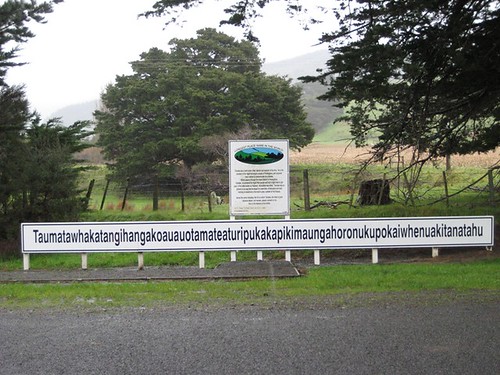


Taumata, the hilltop with the world’s longest place name
Taumatawhakatangihangakoauauotamateaturipukakapiki-maungahoronukupokaiwhenuakitanatahu is the longest place name in the world. It is the name given by the local Maori people, Ngati Kere to a hill to celebrate the eponymous ancestor Tamatea Pokai Whenua.
(c.A.D. 1350).Legendary traveller.
Tamatea was a famous chief and warrior of his time. His son Kahungunu was the founder of the Ngati Kahungunu tribe which extends from Gisborne to Cape Palliser.
Tamatea acquired his long name through different happenings in his life.
Tamatea-Pokai-Whenua was born in Hawaiki in the period before the Great Migration. He was the son of Rongokako and a descendant of the legendary Maui. He came to New Zealand in the Takitimu canoe but left it at Turanga (Gisborne) and travelled overland, keeping close to the coast, until he reached Ahuriri. There, according to the legend, his pet crocodile, Tapu-Te-Ranga, escaped. From Ahuriri he continued towards the Ruahines, but his son, Kahungunu, was unwilling to cross them and returned to settle on the Heretaunga Plains. Tamatea continued his journey until he reached a high mountain, where another of his pets, the serpent, Pohokura (or Pukeokahu), escaped. When he reached the Moawhango River Tamatea plunged the brands from his fire into the waters, where they became taniwhas (spirits) and may be seen to this day. As he walked along the beach towards Wanganui, his dog ran into the sea and became a taniwha. Shortly before he reached the pa at Wanganui, Tamatea paused to dress his hair. From this circumstance, the place became known as Putiki-waranui-a-Tamatea or Tamatea's top-knot. He paddled up the Wanganui River until he reached Omaka, where there proved to be no anchorage. Tamatea therefore bent one of the rocks in the river and tied his canoe's anchor cable about it. He reached Lake Taupo and paddled his canoe across it to the Waikato River, but lost his life shortly afterwards when he tried to shoot the Huka Falls.It appears that while travelling through the back of Porangahau, Tamatea encountered the Ngati-Hine tribe and had to fight them to get past. The battle is known as the Matanui battle and during that fight his brother was killed.
Tamatea was so grieved over the loss of his brother that he stayed for quite a long time at that place and each morning he would sit on the knoll and play his lament on what is called Koauau or Maori flute.
In the course of his travels Tamatea-Pokai-Whenua left his name upon many geographical features: the most famous of these is a little hill, near Porangahau, Hawke's Bay, called Taumatawhakatangihangakoauauo-tamateapokaiwhenuakitanatahu or “the hill where Tamatea-Pokai-Whenua played his flute….”
Tamatea had two wives. His principal wife, Iwirau, was the mother of Kahungunu, the eponymous ancestor of the Ngati Kahungunu; his other wife, Mahakiroa, was the mother of four sons, including Apa, the eponymous ancestor of the Ngati Apa.
Tamatea-Pokai-Whenua, or Tamatea-who-encircled-the-land, is the great land traveller of Maori tradition. He is not to be confused with Tamatea-Ariki-Nui, the captain of Takitimu canoe.
Turipukaka-pikimaunga-tahu was given through his many raids and wanderings and he was such a huge muscular man that his name suited him.
Hence the name Taumata-whaka-tangihanga-koauau-o-Tamatea-turi-pukaka-pikimaunga-horonuku-pokai-whenua-kitana-tahu, which means ‘The hilltop where Tamatea with big knees, conqueror of mountains, eater of land, traveller over land and sea, played his koauau to his beloved.’
This lament is still sung at many tangi.
From the top of the hill, one can see the peak of the Te Awa Putahi, the spiritual ancestral mountain claimed by Ngati kere and, looking inland to the west, the long flat peak of Raekatia, the spiritual mountain there is a pinnacle called — Tetaumatawhakatangihangakoauauorangitane to celebrate Rangitane, the eponymous ancestor of the Tamaki Nui a Rua district.
No comments:
Post a Comment